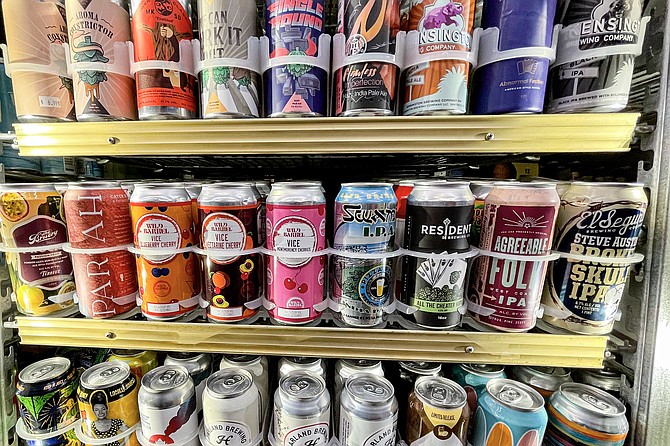 Facebook
Facebook
 X
X
 Instagram
Instagram
 TikTok
TikTok
 Youtube
Youtube

UPDATE: Effective Saturday, March 13, California has removed the meal service requirement for breweries, distilleries, and bars. Until 8pm each day, customers may order adult beverages without also ordering food, for on premise, outdoor consumption.
It’s been roughly fifty-two weeks since I first used the word pandemic in a beer story, and though I’ve had to do so dozens of times since, this time there’s finally reason for optimism. Between the falling number of covid cases and rising number of vaccinations in San Diego County, there are signs that an end to the restrictive public health policies that have hampered local beer and booze businesses may finally be on the horizon.
After a prolonged winter in the restrictive purple tier of California’s “Blueprint for a Safer Economy,” which bans indoor dining, San Diego is poised to enter red tier as soon as next week. That will officially allow brewpubs and tasting rooms with meal service to resume indoor on-premise drinking at 25 percent capacity.
Vaccinations became available to service workers in late February, which means most brewery workers should be vaccinated by the time indoor capacity rise to 50 percent. That will happen when San Diego enters the orange tier, which will allow outdoor drink service to resume for bars and breweries that do not offer meal service. Fortunately, the criteria for entering the orange tier becomes much easier to reach as vaccination numbers rise. As three vaccines (Pfizer, Moderna, and Johnson & Johnson) are now being administered, there’s no official timeline yet, but it’s reasonable to expect graduating to the orange tier by April, and to the less restrictive yellow tier by the summer.
On-premise service is significant to breweries in two major ways. First, it allows them to bring more hospitality employees back to work.
The second is that even a return to 25 and 50 percent capacities will increase brewery revenue in the near term. Breweries can bring in several times more revenue on pints poured in a taproom than sold by the can.
As government subsidies and eviction moratoriums fade away, many breweries may find themselves at increased risk of going under as things return to normal, and they have to account for operating losses and increased debt. The only way out of the hole for some will be the mass return of beer fans to taprooms.
For things to return to normal, a county full of self-isolating beer enthusiasts will have to unlearn the drinking at home habits we forged during this covid year.


UPDATE: Effective Saturday, March 13, California has removed the meal service requirement for breweries, distilleries, and bars. Until 8pm each day, customers may order adult beverages without also ordering food, for on premise, outdoor consumption.
It’s been roughly fifty-two weeks since I first used the word pandemic in a beer story, and though I’ve had to do so dozens of times since, this time there’s finally reason for optimism. Between the falling number of covid cases and rising number of vaccinations in San Diego County, there are signs that an end to the restrictive public health policies that have hampered local beer and booze businesses may finally be on the horizon.
After a prolonged winter in the restrictive purple tier of California’s “Blueprint for a Safer Economy,” which bans indoor dining, San Diego is poised to enter red tier as soon as next week. That will officially allow brewpubs and tasting rooms with meal service to resume indoor on-premise drinking at 25 percent capacity.
Vaccinations became available to service workers in late February, which means most brewery workers should be vaccinated by the time indoor capacity rise to 50 percent. That will happen when San Diego enters the orange tier, which will allow outdoor drink service to resume for bars and breweries that do not offer meal service. Fortunately, the criteria for entering the orange tier becomes much easier to reach as vaccination numbers rise. As three vaccines (Pfizer, Moderna, and Johnson & Johnson) are now being administered, there’s no official timeline yet, but it’s reasonable to expect graduating to the orange tier by April, and to the less restrictive yellow tier by the summer.
On-premise service is significant to breweries in two major ways. First, it allows them to bring more hospitality employees back to work.
The second is that even a return to 25 and 50 percent capacities will increase brewery revenue in the near term. Breweries can bring in several times more revenue on pints poured in a taproom than sold by the can.
As government subsidies and eviction moratoriums fade away, many breweries may find themselves at increased risk of going under as things return to normal, and they have to account for operating losses and increased debt. The only way out of the hole for some will be the mass return of beer fans to taprooms.
For things to return to normal, a county full of self-isolating beer enthusiasts will have to unlearn the drinking at home habits we forged during this covid year.
Comments